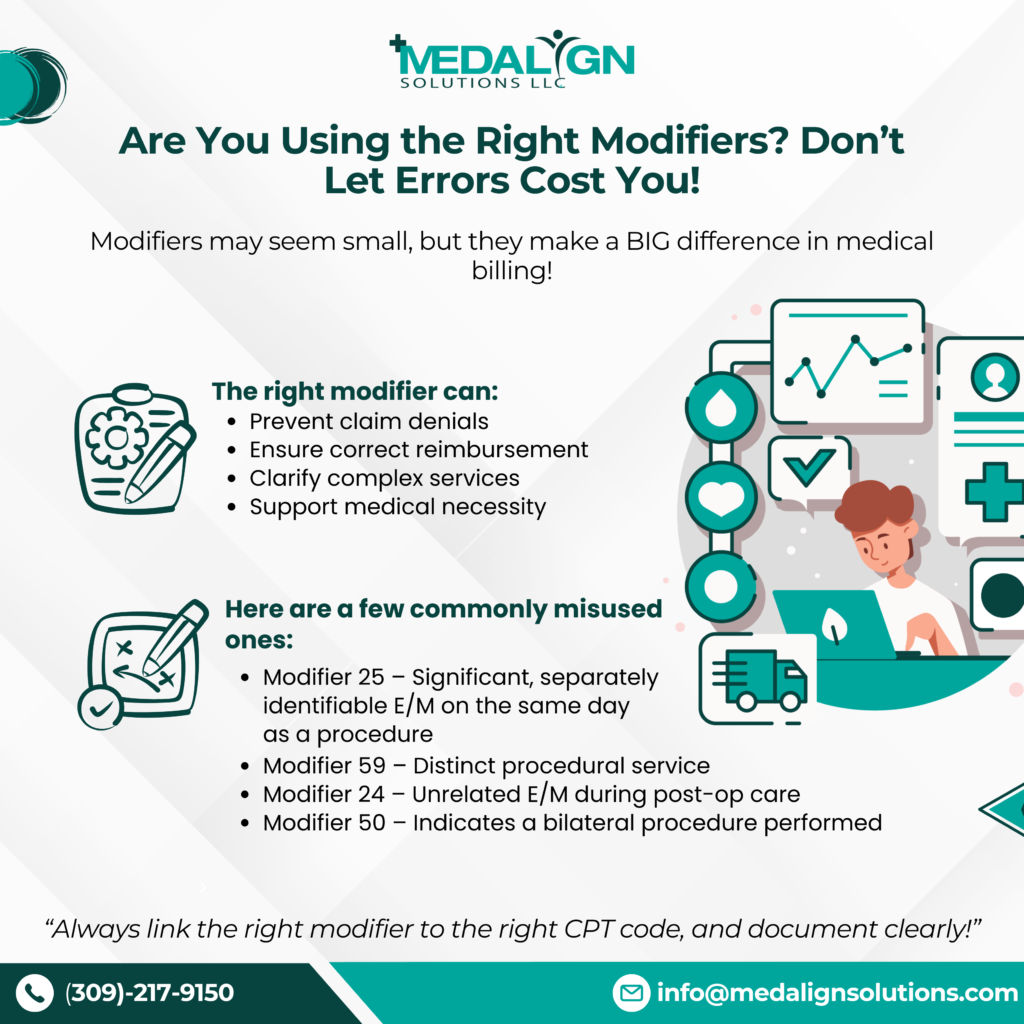
Introduction:
Are CPT modifiers sabotaging your reimbursements?
In the ever-evolving world of medical billing, the smallest oversight, like misusing a CPT modifier, can result in claim denials, compliance issues, and revenue loss. At MedAlign Solutions, we help providers navigate these technicalities with precision and accuracy.
In this blog, we’ll break down the 7 most common modifier-related mistakes in medical billing and show you how to avoid costly errors to ensure smooth revenue cycle management.
1. Misuse of Modifier 25, More Than Just a Routine Visit
Modifier 25 indicates a significant, separately identifiable evaluation and management (E/M) service by the same physician on the same day of a procedure.
Common mistake:
Using Modifier 25 inappropriately for visits where the E/M service isn’t distinctly separate from the procedure.
Impact: Increased risk of audits and denials.
Example:
A patient presents for a wart removal, and the provider documents only that procedure. Adding Modifier 25 without additional evaluation or decision-making is incorrect.
How to Avoid It:
- Document the separate E/M service clearly in the chart.
- Ensure that the service meets the criteria for being “significant and separately identifiable.”
Billing Tip: Always ensure medical necessity and clearly differentiate between the E/M service and the procedure.
2. Overuse or Misuse of Modifier 59, The Most Abused Modifier
Modifier 59 is used to indicate distinct procedural services, but it’s often overused.
Common mistake: Applying it to bypass Correct Coding Initiative (CCI) edits when not necessary.
Example: Billing Modifier 59 on procedures with established NCCI edits without proving distinct services.
How to Avoid It:
- Use specific subset modifiers (XE, XS, XP, XU) when appropriate.
- Clearly document how each service is distinct or performed in different sessions or body sites.
Billing Tip: Use Modifier 59 only when no other modifier (like XE, XS, XP, or XU) more accurately describes the situation.
3. Forgetting Modifiers Altogether, A Costly Omission
Failure to use appropriate CPT modifiers often results in claim rejections or underpayment.
Common mistake: Submitting claims without a modifier when one is required for specificity.
Billing Tip: Always verify if your billed service requires a modifier to reflect correct coding guidelines.
4. Incorrect Sequencing of Modifiers, Order Matters
Some modifiers need to be in a specific order on claims (e.g., pricing modifiers first).
Common mistake: Placing informational modifiers before payment-affecting modifiers.
Billing Tip: Refer to your payer’s rules regarding modifier order for clean claims.
5. Using Modifiers with Incompatible CPT Codes
Certain modifiers are invalid with some CPT codes, and pairing them incorrectly can lead to denials.
Common mistake: Applying modifiers like Modifier 22 with codes that don’t allow for unusual procedural services.
Billing Tip: Use a reliable billing software or coding partner like MedAlign Solutions to cross-check compatibility.
6. Using Modifiers to Bypass Medical Necessity Edits
While modifiers can explain why a service was performed, they don’t override medical necessity.
Common mistake: Adding Modifier 59 or 25 in hopes of forcing payment despite documentation issues.
Billing Tip: Always support your claim with robust clinical notes that justify the service provided.
7. Not Staying Updated with Modifier Changes and Guidelines
Modifier definitions change regularly based on updates from CMS, AMA, and commercial payers.
Common mistake: Using outdated coding guidelines or relying solely on previous approvals.
Billing Tip: Stay ahead with continuous education and trust MedAlign’s billing experts to keep your practice compliant.
Partner with MedAlign to Get Modifiers Right
Modifiers may seem small, but their impact on revenue and compliance is massive. If you’re unsure whether you’re using the right CPT modifiers, you’re putting your practice at risk.
At MedAlign Solutions, our certified coders ensure accurate modifier use, prevent denials, and maximize your reimbursement potential.
Book a free billing audit with MedAlign Solutions today!
Contact us today for a free consultation and see how we can help you increase revenue, reduce denials, and focus on what matters most, caring for your patients.
Visit us at MedAlign Solutions LLC
Email us: Info@medalignsolutions.com
Follow us on Facebook, Instagram, and LinkedIn and stay updated on the latest in medical billing.




